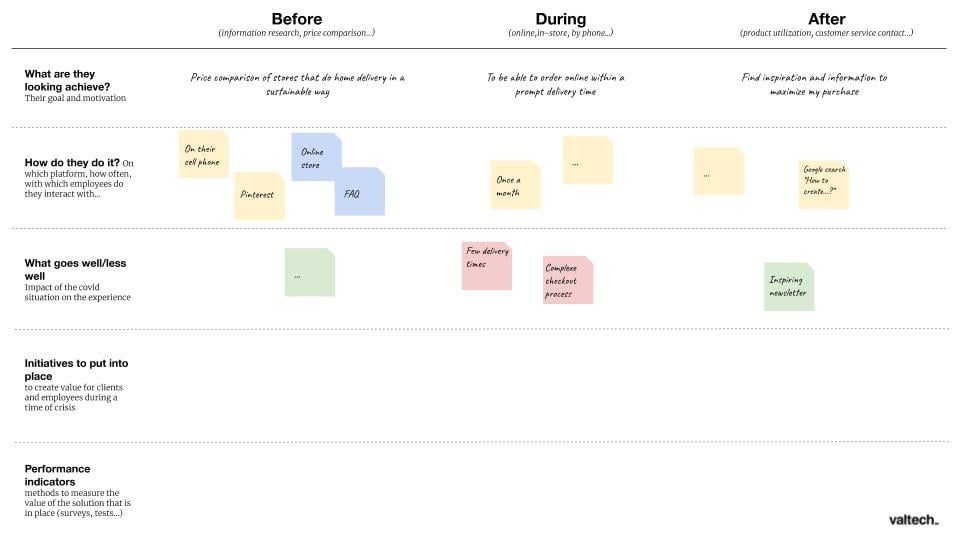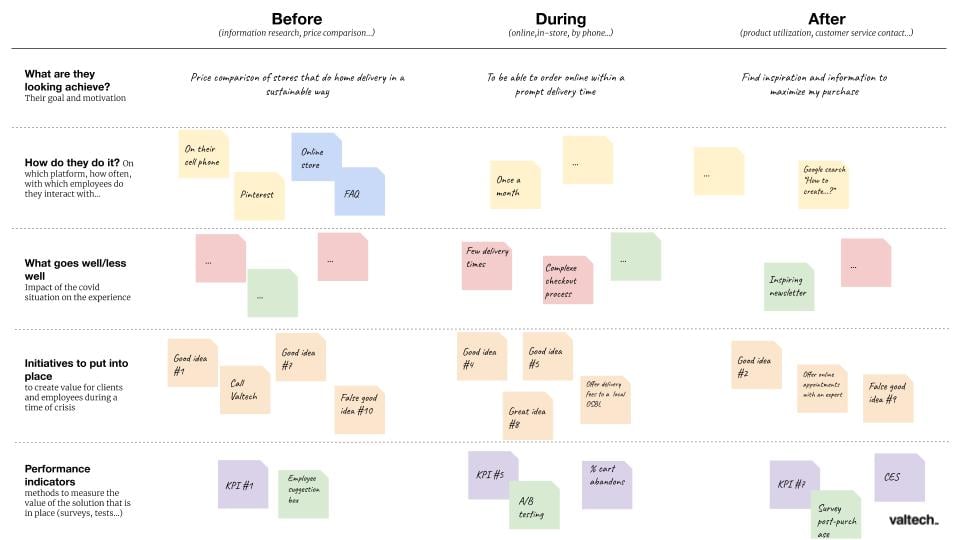01. August 2020
What seemed impossible to us a few months back now seems obvious: the way we live our lives has changed and will be constantly evolving in the coming months, if not for the next few years.
For some companies, the adjustments are relatively easy to identify and implement. For others, there are several stages in the customer journey that need to be reviewed. And in some cases, the entire customer experience needs to be completely reinvented.
Customer experience mapping is an excellent tool to summarize all the interactions between your company and your customers. It can help in identifying the points of contact most affected by the crisis, your customers new needs as well as the key instances in the journey that need to be reviewed.
In a “normal” context, mapping the customer experience is a project that can be conducted over multiple weeks, including qualitative and / or quantitative consumer research, several multidisciplinary co-creation workshops, ideation with various company stakeholders as well as validation with target customers, etc.
But in the current context, where it’s necessary to react quickly, it’s possible instead to create what is called a “proto-customer journey”, that is to say a simplified version of a customer journey experience.
This will give you a clear overview of your customers interactions with your business as well as what needs to be reviewed in the current context, which will help you quickly adapt to changing circumstances with solutions that truly meet your customer’s needs. This gesture will be appreciated.
The Steps to Creating a Proto-Journey
Step 1: Put yourself in your Customers Shoes
To map your customers experience, you must start by understanding the experience they have. While we always recommend reaching out to your customers to understand them better, in today's environment you may not have the time or the budget to do consumer research. In this case, turn to available information such as satisfaction surveys, analytical data from your digital platforms, customer service reports, interviews with employees in contact with customers, publicly available studies, etc.
With this information, start by establishing proto-personas, meaning customer profiles who have specific needs, interests and habits, and that differ from each other. This will allow you to map the customer experience with multiple perspectives in mind.
For example, a retailer could define 3 proto-personas:
- a young, urban woman who likes to take the time to get inspired and shop online,
- a retired couple who live in the suburbs and who enjoy going to the store every week because it’s a little outing they look forward too,
- a father who knows exactly what he needs and for whom shopping should be quick and efficient.
Afterwards, start to sketch your personas’ proto-journey:
- start by placing on a horizontal line, the main stages of your customers journey,
- then, below each step, place all the information that you collect during your research: their purpose, their state of mind, the information sought or the task to be accomplished, the channels used and the contexts of use, the employees of your organization with whom they come into contact, etc.
Whenever your customers come into contact with your company, analyze what is going well and what is appreciated - which can therefore be reinforced - and what is less appreciated, or which no longer works in the current context - which therefore needs to be improved or completely revised.
Depending on the time and the information you have, you can choose to make a journey for each persona, or a single journey common to all your personas. In the case of the latter, you can use different colors for the insights that are common to all personas and for those that are specific to just one.
Congratulations! You have taken the first steps towards mapping your proto-customer journey!

Example of a rough outline
Step 2: Co-create with Different Points of View
Once you have gathered the available information and begun to map your customer experiences, organize virtual co-creation sessions with your colleagues, in order to complete the proto-journey with the help of the knowledge they have acquired of your customers.
To get the most out of these sessions, be sure to bring together a multidisciplinary group of employees in your organization who are in direct contact with customers. Invite people from different teams and from different hierarchical levels, as this will bring you more wealth in the customer insights you will collect, in addition to promoting employees’ mobilization and buy-in to the process.
In these remote working sessions, we advise you to limit the number of participants to 10 or 12 and to limit the duration to 1h30 or 2h maximum. Organize several sessions if necessary, with different business lines, regions, etc., to get as much customer knowledge as possible.
If you need advice to prepare and lead this kind of remote workshop, see our article Work Must Go on(line)!
These sessions will allow you to complete mapping your customers' new reality, to list their new ways of interacting with your company and to identify the impact on their satisfaction.
Step 3: Leverage Collective Intelligence for Ideation and Prioritization
Once you’ve considered that you have a fairly complete view of this new reality, it’s time to identify the major pain points in your customer journey and transform them into initiatives that will create value for your customers, and your organization.
Don’t forget that this approach is also an opportunity to review the customer journey from the employees’ point of view, in order to help them better accomplish their work, because they too are affected by this crisis both professionally and personally.
For this step too, don't hesitate to organize multidisciplinary working sessions with your colleagues: collective intelligence does wonders when it comes to finding new ways of doing things. First, allow your participants to diverge as much as possible (the sky is the limit), then bring the best ideas towards realistic solutions.
If you need inspiration for ideation activities, there are many free online toolkits, such as ones found on Hyper Island.
Once you have defined solutions to the identified pain points, begin to prioritize, because you won’t be able to be on all fronts at the same time. Again, a multidisciplinary team will allow you to prioritize based on several criteria: technical, human, financial, etc.
Step 4: Validate the Solutions with Employees and Customers
Before establishing a game plan to implement the solutions, it’s essential to involve all the team representatives that will be impacted by these solutions: this will allow you to acquire their fidelity fairly early in the process since they will have contributed to the validation and implementation of the solution.
If you have the possibility, don’t hesitate to involve your clients in this prioritization step: after all, it’s for them that you’re doing all of this for, so best to validate that the changes you wish to bring are valuable in their opinion.
Remember, no need to take out the heavy research artillery. Start by looking around you amongst your circle of friends or your close contacts to see if there are any people who use your products or services and if so, take a little time (by phone) with each of them to ask them their opinion. You can also use your social networks and your email database to expose some of your customers to your ideas and gather their feedback.
Plan a review period and adjust solutions in order to take into account the employee and customer feedback you have received.
Step 5: Measure and Adjust
As we mentioned at the beginning of this article, we’re in a period where everything is rapidly changing. This makes it even more important than usual to measure and adjust as you go.
Therefore, in your solution implementation plan, don’t forget to define key performance indicators that are easy to monitor so that you can quickly react if the solutions aren’t reaching the expected results.

Example of a completed proto-journey
So that it’s for the methodology (the form). In terms of substance (the solutions that you will put in place to deal with this crisis and your customers’ new needs), it’s certain that the changes to be implemented will be different for every company , depending on their context, their capabilities and the impact the crisis has on their activities.
That being said, there are a few common denominators in the direction that companies should focus their efforts in order to meet consumers expectations in this time of crisis, that should be kept in mind during your reflection process.
In this Time of Crisis, what do Consumers Expect from Businesses?
People want usefulness
In times of crisis more than ever, people expect helpful responses and services from companies. As you work to rethink your organization’s customer experience, identify the levers that allow you to make yourself useful with what you do best.
People value empathy and generosity
During this difficult time, show empathy in all your initiatives, communications, points of contact, etc. It’s little extra effort that you may have only made in certain cases before, so why not do it systematically now?
Whenever feasible, open up to as many people as possible. For example, offer advice or tools that were only available to members or clients in the past, as some yoga schools are doing now by offering online classes free of charge or voluntary contribution.
People want local
The current crisis has highlighted the importance of consuming and sourcing locally in order to encourage our local economies and to avoid being dependent on other countries to meet our needs. There’s even a boom in the hyper-local market, as demonstrated for example, by the sudden craze for urban agriculture.
In your reflections, ask yourself how your organization could follow this trend and rethink its activities to strengthen ties with its local community.
People need to be reassured
In your new ways of interacting with your customers, it’s important to show them that you’re in control. Adopt a reassuring tone of voice and measures that prove to customers that you are acting humanely, that they can trust you and that you’re there to offer them solutions adapted to their needs.
Although all these changes can be destabilizing and generate unforeseen costs, think in the medium to long term: your customers won’t forget the positive impact that your actions will have made to make their lives easier in this difficult time.
A special thanks to Marie Boubet, Designer UX and Adeline Huar, Writer for their contribution to this article.








